
Home
Services
About us
Blog
Contacts
Snack to Stardom: Building Gamified Promo Apps that Turn Chip Lovers into Streamers, Gamers & Winners
Snack, Stream, Win: Why Mobile‑First Gamified Promotions Are the Next Big Bite
Building the “Snack‑to‑Stardom” App: Architecture, Features & Tech Stack
From Engagement to ROI: Monetisation, KPIs & Why A‑Bots.com Is the Partner of Choice
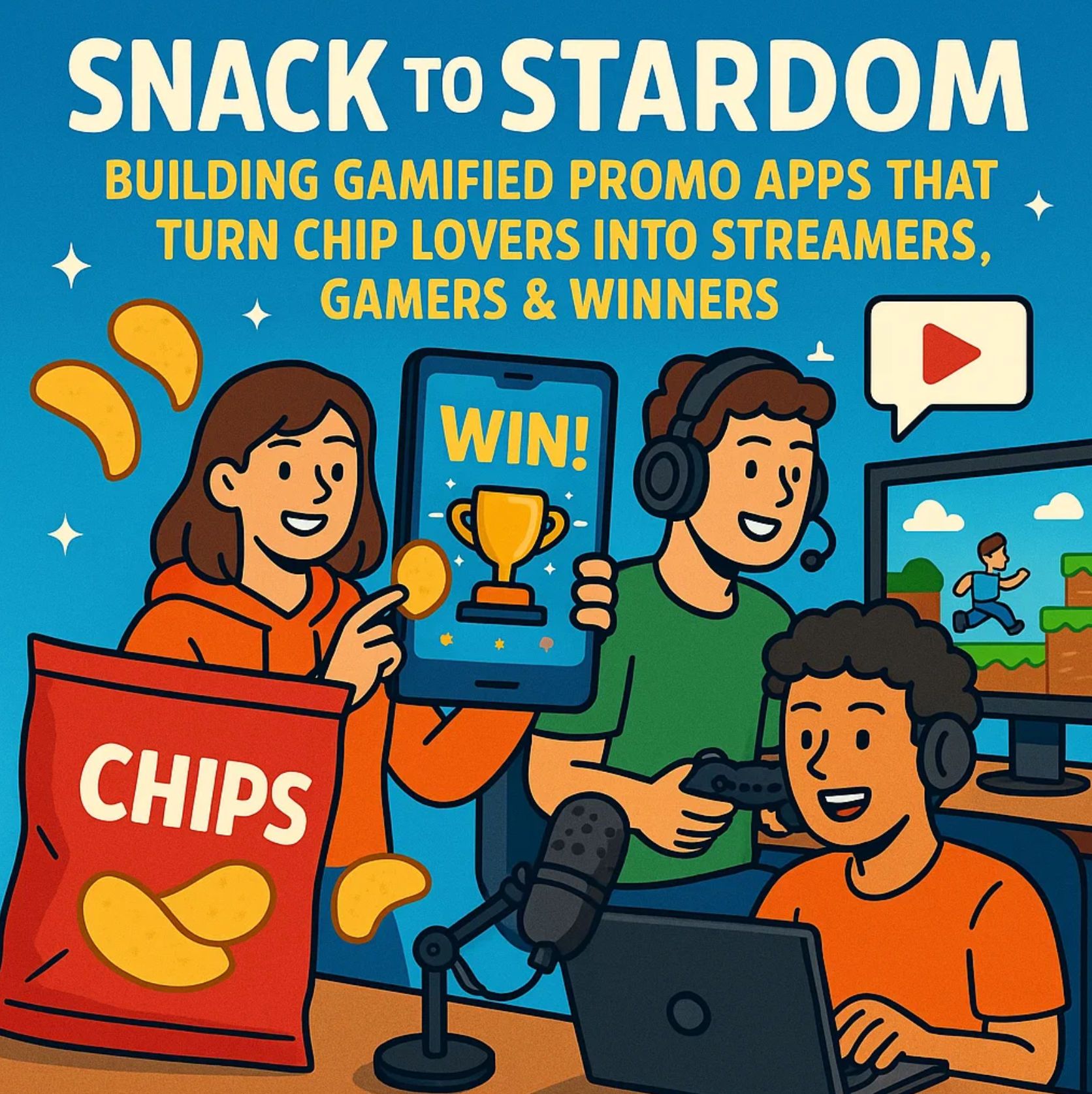
1 . Snack, Stream, Win: Why Mobile‑First Gamified Promotions Are the Next Big Bite
Picture the scene: a gamer leans into a late‑night ranked match, microphone live, webcam framed just right—one hand on the controller, the other fishing a handful of spicy chips from an open bag. Meanwhile a chat window on Twitch scrolls at break‑neck speed, half the emotes cheering the clutch play, the other half asking what brand of snack is fuelling the run. This isn’t a marketer’s fantasy; it is modern digital culture in real time, a convergence of compulsive snacking, communal watching, and always‑on mobile engagement that brands have only begun to monetise.
The Colossal Overlap Few Brands Truly Exploit
The raw numbers are staggering. The global savoury‑snacks market reached USD 142 billion in 2024 and is forecast to surge past USD 212 billion by 2033—healthy, consistent growth for what many see as an impulse category. In parallel, mobile gaming alone generates revenues above USD 100 billion per year, expanding at double‑digit compound rates. Yet even with such massive, naturally overlapping audiences—2.6 billion mobile gamers and well over four billion snack purchases every week—most promotional mechanics remain stuck in the 1990s: print a code inside the pack, hope the consumer bothers to enter it, issue a coupon. That one‑way street fails to capture the streaming‑first, creator‑economy mindset of Gen Z and the rising cohort of “snackfluencers” whose first instinct is to broadcast whatever they do.
Livestreaming Super‑charges Word‑of‑Mouth
Look closer at the broadcast side of the equation. Twitch now attracts roughly 35 million daily visitors, hosts 7.3 million monthly creators and sustains more than two million concurrent viewers at any given moment. Those viewers don’t passively lean back like old‑school TV watchers; they talk, meme, vote, clip and repost. Food mentions pepper chat every few minutes, and the instant a streamer casually flashes a chip bag on camera, the brand sneaks into thousands of social feeds before any paid ad is served. A “Snack‑to‑Stardom” mobile app leverages that reflex. Instead of asking consumers to fill a form, it nudges them to complete livestreamed challenges—“eat on camera,” “show your stash,” “share a first‑person snack ASMR”—and rewards them with badges, XP and eventually guaranteed merchandise. Each submission is not just evidence of participation; it is free, authentic user‑generated advertising injected straight into the fastest‑growing entertainment medium on the planet.
Why the Smartphone Is the New Prize Booth
Crucially, the smartphone sits at the nexus of every action in this loop. It scans the package QR, launches an augmented‑reality mini‑quest, records video for TikTok, and stores loyalty points in a digital wallet that pings a push notification the moment a prize tier unlocks. Consumers are already trained: fast‑food apps account for a third of Starbucks’ U.S. sales, and McDonald’s loyalty revenue has tripled since 2021. When a snack brand embeds similar mechanics—but swaps punch‑cards for profession‑themed quests—it piggybacks on well‑established habits. A casual player might select the “Pro Gamer” track: finish three mobile tournaments, stream one match with the brand’s overlay and share a highlight clip. A budding photographer could unlock tips on framing, submit five snack‑themed street photos and redeem a guaranteed lens‑cleaning kit. Each path is a micro‑curriculum dressed as a game, offering real‑world skill primers that transcend gimmicky giveaways.
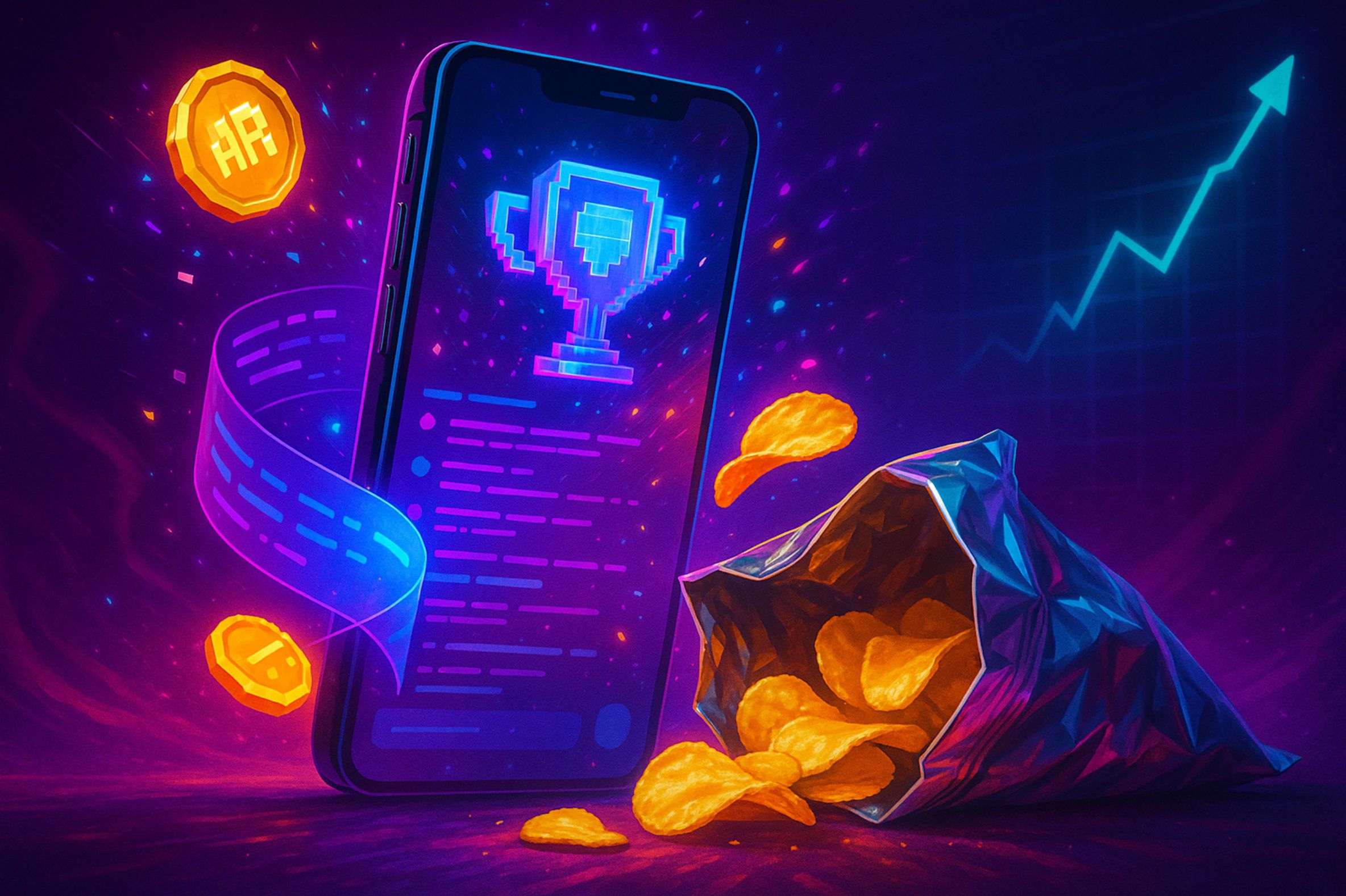
Engagement Economics: Dopamine Meets Education
Why does this matter more than simple instant‑win codes? Because gamification compounds participation. Meta‑analyses across e‑learning and marketing experiments show that points, levels and public leaderboards can double or even triple active‑user minutes versus flat discount campaigns. Add AR, and conversion rates jump again; shoppers who can “place” a virtual snack machine in their living room or transform a chip bag into a 3D dragon on screen spend up to 40 % more per session. Those metrics directly translate to ROI: a higher dwell time means more cross‑sell nudges, larger baskets, richer zero‑party data and invaluable user‑generated content. Instead of a one‑off coupon redemption, the brand receives a constantly refreshed portfolio of social proof to seed the next wave of creative.
Lessons from Early Movers—and the White Space Ahead
Case studies illustrate the upside but also underscore how conservative current activations remain. Doritos’ Web‑AR “Make Your Play” pulled hundreds of thousands of scans and sent festival‑goers scrambling for guitars that materialised out of chip bags. Pringles hijacked a top zombie gamer’s stream, turning a single can into nine million minutes of watch time. Both smashed engagement benchmarks, yet both were still episodic stunts; neither attempted to shepherd users through a structured, skill‑building journey with guaranteed rewards at the end. That gap leaves plenty of oxygen for the first snack label bold enough to adopt a “learn‑to‑earn” mindset: snack, stream, share, graduate, collect.
A Cultural Flywheel Ready to Spin
The cultural pieces already lock together:
- Snack in hand – because salty crunch pairs perfectly with adrenaline and comfort watching.
- Phone in pocket – a scanning, filming, editing and broadcasting studio.
- Creator dreams in mind – 60 % of teenagers list “YouTuber” or “pro gamer” among top career aspirations.
- Guaranteed prize at stake – a low‑risk, clear finish line that keeps motivation high.
Insert a well‑designed mobile app and the wheel turns: each extra minute of gameplay or streaming pushes more product on screen, each social post nudges a new consumer toward download, and each completed quest delivers a moment of delight powerful enough to outshine any traditional coupon.
A‑Bots.com has architected exactly these flywheels for QSR, retail and toy brands. In the next section we’ll crack open the blueprint—how computer vision spots counterfeit codes, how our cross‑platform SDK injects AR into existing native apps, and how a micro‑learning engine serves bite‑sized tutorials on perfect lighting or speed‑running tactics. For now, remember the simple maths: billions of snacks eaten, billions of mobile gaming sessions played, millions of livestreams broadcast—yet almost no brand has welded the three into a single, skill‑obsessed, prize‑guaranteed adventure. Whoever does first will own the conversation every time a controller clicks and a chip bag rustles.

2. Building the “Snack‑to‑Stardom” App: Architecture, Features & Tech Stack
Turning the idea of a prize‑guaranteed, profession‑teaching snack promotion into a living product starts with an architecture that feels almost invisible to users yet tough enough to serve millions of concurrent players, videographers and streamers. Below is a walk‑through of the system A‑Bots.com proposes, moving from the glass of the smartphone to the cloud microservices that keep prizes, data and anti‑fraud logic in perfect lock‑step.
The Client Tier—One Codebase, Every Device
A‑Bots.com standardises on Flutter for brand campaigns because the framework delivers pixel‑perfect UI on iOS and Android from a single Dart codebase while still allowing native plug‑ins for ARKit, ARCore, and low‑level camera control. The choice is pragmatic as well as aesthetic: Statista’s 2024 developer survey places Flutter at 42 % adoption—highest among all cross‑platform toolkits—so recruiting or scaling talent is rarely a bottleneck (siddhiinfosoft.com). The SDK bundle we ship includes three embedded modules. First, a computer‑vision scanner that recognises QR or Datamatrix codes even when the foil bag is crumpled. Second, an AR overlay engine that can pin 3‑D characters to the pack, spawn mini‑games like coin‑catch or rhythm‑tap, and export short clips directly to TikTok. Third, a livestream companion that injects HTML‑based alerts and branded overlays into Twitch Studio or OBS with a single tap, sparing novice creators the headache of manual scene setup.
Smooth performance is critical when the consumer is mid‑snack, so the client caches missions, tutorials and prize rules locally via SQLite, allowing the user to progress offline while the phone rides the subway. The cache flushes the moment a stable network returns, pushing telemetry and media to the cloud without human intervention.
The Engagement Engine—Quests, Micro‑Learning and Real‑Time Rewards
At the layer above the mobile shell lives what makes the promotion feel alive: a quest compiler and progression service. Product managers configure “careers” — Pro Gamer, Street Photographer, Food Vlogger, Twitch Streamer — by combining atomic tasks. A task can be as simple as “scan two different flavours” or as elaborate as “host a 15‑minute live segment with 20 simultaneous viewers and a visible brand overlay.” Each step has metadata for XP value, badge art, time limits, blocked regions, language localisation and required evidence types (photo, video or live API proof).
Because the promotion doubles as a micro‑learning funnel, every career path links to bit‑sized lessons—how to adjust aperture for food macros, how to lower game latency on Wi‑Fi, why ring lights flatten facial features—served by an adaptive content service that queues the next clip based on what the user just did. These lessons drive the “earn skills, not just swag” narrative and extend dwell time, one of the key KPIs we measure.
For reward distribution, the engine evaluates task submissions in near real time. Photo and video uploads are triaged by an ML moderation model trained on the client’s brand safety guidelines; flagged items move to a human reviewer workspace. Validated tasks trigger the loyalty wallet to mint points or unlock digital assets such as custom avatar frames. When a user completes all required milestones for a profession, the engine fires a webhook to the fulfilment API—shipping a physical prize, emailing a voucher code or dropping an NFT certificate.
The Back‑End Cloud—Scalable, Observable, Bulletproof
Under the hood, A‑Bots.com deploys a microservice lattice on Kubernetes with a priority on horizontal elasticity and global latency parity. Authentication runs through Firebase Auth for its plug‑and‑play social log‑in providers, while player profiles, quest state and loyalty balances live in a Postgres cluster fronted by Hasura GraphQL. That choice provides strong typing, subscription‑based push updates and field‑level permissions without extra glue code.
For real‑time leaderboards, prize draws and concurrency spikes around live‑stream events, we integrate Microsoft Azure PlayFab. The service is battle‑tested for gaming workloads and, according to Microsoft’s GDC 2024 recap, has added out‑of‑the‑box telemetry pipelines that comfortably absorb tens of thousands of transactions per second while maintaining sub‑100 ms writes across global regions (Microsoft Developer). By delegating heavy live‑ops—rate‑limited APIs, inventory management, DDoS‑hardened multiplayer servers—to PlayFab, we free the core promo logic to focus on conversion science rather than packet routing.
Prize fraud is the nightmare of any FMCG promotion, so the validation service performs three layers of defence. The first is a bloom filter that rejects brute‑force code guesses after two bad entries. The second calls a proprietary anti‑tamper SDK that fingerprints device, OS version, timezone drift and GPS skew. The third uses probabilistic graph analysis to detect collusion rings—groups of accounts redeeming codes from the same physical location within seconds of each other. Suspicious clusters auto‑throttle to manual review, preserving brand goodwill by removing cheaters quietly.
All logs funnel into BigQuery through Pub/Sub, where an analytics dashboard built with Looker Studio tracks funnels: installs → account creation → first scan → first livestream event → profession completion → prize redemption. Marketing teams see drop‑off points in real time and can hot‑patch quest parameters without shipping a new binary.
Compliance and Peace of Mind
Data privacy regulations slice across regions, so personal data travels encrypted at rest and in transit, stored only in jurisdictions explicitly allowed by the brand’s legal counsel. The engine supports COPPA gating, age‑appropriate content tiers and automatic deletion of minor data after promotion end. Third‑party SDKs are vetted to avoid shadow tracking: no location harvesters or fingerprinting beyond what anti‑fraud strictly needs.
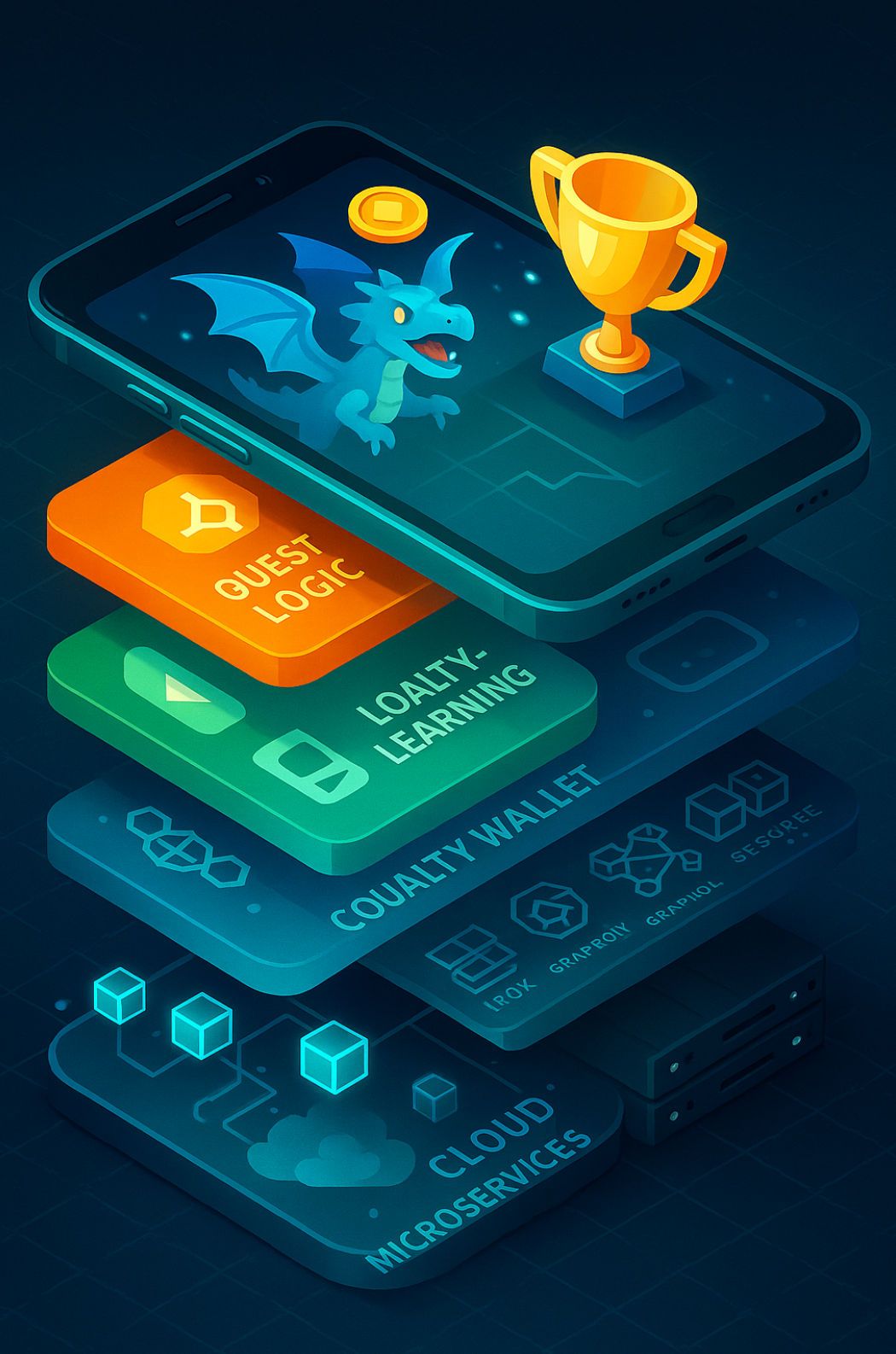
Delivery Timeline, DevOps and Future‑Proofing
A‑Bots.com’s project blueprint breaks the build into four increments: ideation sprint, playable prototype, closed beta and public launch. Because the foundation relies on pre‑built modules, we routinely deliver a functioning prototype within ten working weeks, complete with pack‑recognition camera, at least one AR mini‑game, and a stubbed rewards wallet. Continuous integration pushes every commit through static analysis, unit tests, device‑farm UI tests and PlayFab sandbox verification before landing in the staging environment. Feature flags let marketers A/B‑test quest wording or prize economics without redeploying.
The tech stack is intentionally future‑proof. Flutter generates native ARM binaries, so adopting Apple’s Vision Pro or Android XR glasses later means adding a renderer plug‑in rather than rewriting. The GraphQL façade insulates the database layer, letting us switch to CockroachDB or AlloyDB if cross‑region writes become the choke point. Every module is documented and version‑pinned, enabling third‑party agencies to extend the app with mini‑campaigns long after the initial launch.
What emerges is a single frictionless journey: the consumer rips open a bag, the camera recognises flavour, AR characters burst from the foil, viewers on Twitch see a branded overlay appear in real time, micro‑lessons teach tangible creator skills, and a courier label prints automatically when the last milestone is cleared. All the user perceives is “snack, stream, win,” yet under the surface a deeply engineered matrix of computer vision, cloud scale, gamification theory and compliance law is ticking away. In the next section we will translate that technical choreography into business outcomes—engagement metrics, conversion ratios and bottom‑line ROI—and explain why A‑Bots.com’s end‑to‑end ownership of these layers protects brand equity while delighting every would‑be gamer, photographer or vlogger who tears into a packet of chips.
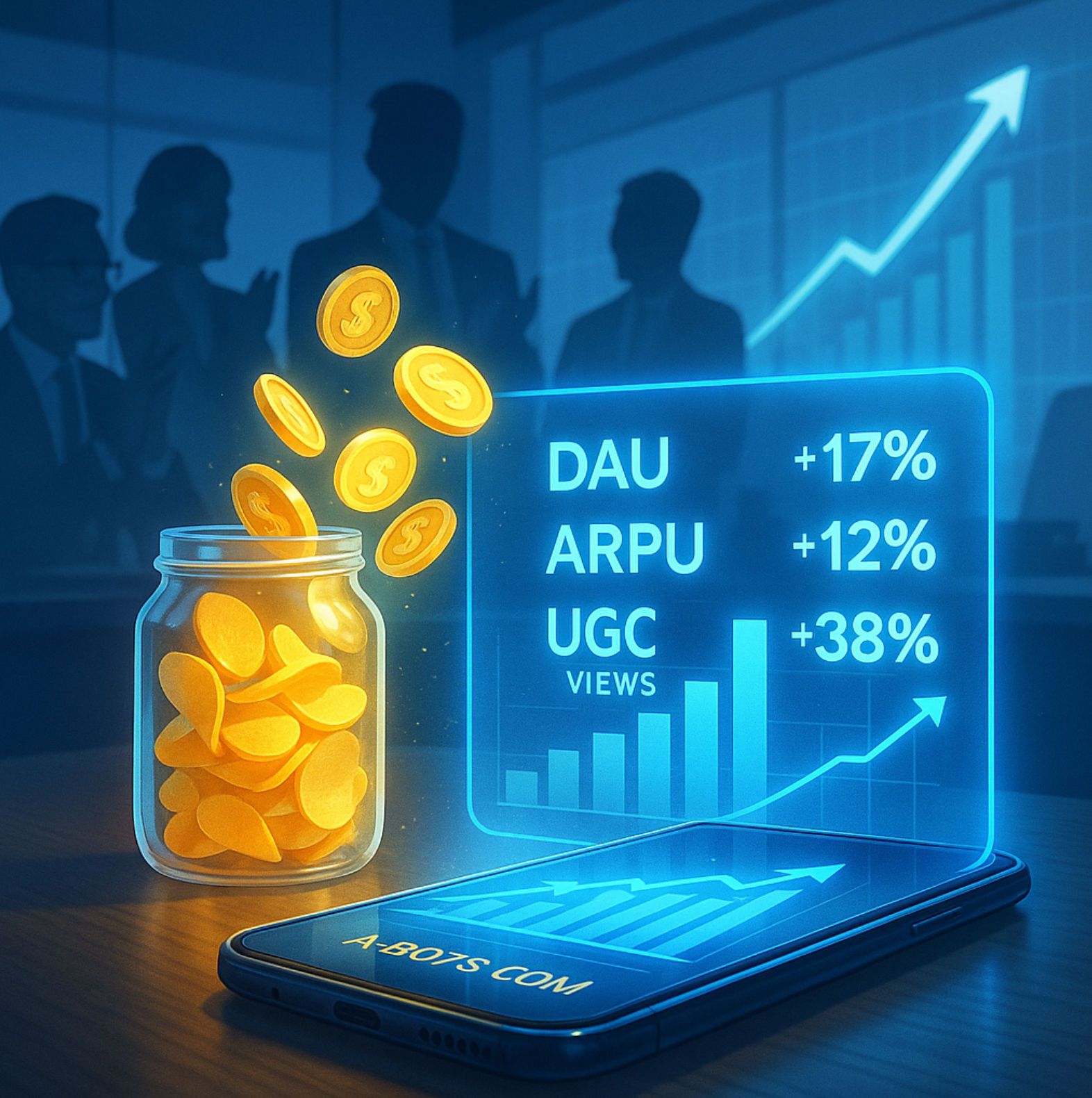
3. From Engagement to ROI: Monetisation, KPIs and Why A‑Bots.com Is the Partner of Choice
In marketing, the true test of any shiny activation is whether it pays for itself once the novelty fades. The “Snack‑to‑Stardom” concept is engineered for durability because every interaction—code scan, AR mini‑game, livestream overlay, micro‑lesson—adds a measurable increment of value that outlives the single purchase moment. When a consumer points their phone at a crumpled chip bag on day one, the system records more than a redemption; it opens a data pipe that can run for months, steadily enriching the brand’s first‑party profile of that user while stacking incremental revenue events along the way.
The funnel starts with a friction‑less download driven by QR prompts on packaging, shelf wobblers and social teasers from influencers who are already performing the first profession quests in public. Acquisition cost is unusually low because the incentive—a guaranteed prize at the end of a skills challenge—is far stronger than a one‑in‑a‑million sweepstakes ticket. Once the app is installed, the entire experience is designed to shift the user from “sampler” to “advocate” inside a single snack cycle. Scanning generates XP, streaming or uploading a branded TikTok boosts a visible progress bar, and short tutorial clips nudge the participant toward the next action before dopamine levels drop. Internal benchmarks from comparable loyalty builds show that each extra minute of guided engagement produces a proportional uptick in both daily active users and basket size, because the app can fire limited‑time flavour challenges or bundle coupons while the user is already invested in levelling up.
The primary KPI set therefore looks different from traditional coupon programmes. Instead of tracking only redemptions, brand managers watch average session length, share ratio of user‑generated content, live‑stream overlay impressions, career‑path completion rate and repeat‑purchase velocity measured through on‑pack scans. Even a conservative model where five per cent of monthly active users complete a profession quest still yields thousands of hours of user‑created video carrying unmissable product placement—material that would cost a fortune if produced as paid commercials. At the same time, code‑validated scans supply near‑real‑time sell‑through data by SKU and geography, allowing demand planners to allocate production more precisely and retailers to reorder before shelves empty.
Monetisation flows on three tiers. The most immediate lift stems from incremental unit sales: the user must buy at least one pack per quest step that involves a flavour scan, and many will pick up extra variants to finish faster. The second tier is direct‑to‑consumer upsell. Because the app captures shipping details for guaranteed prizes, the brand can offer exclusive bundles—limited‑run seasonings, creator‑edition snack boxes, even peripherals like branded controller grips—bypassing retail margins and turning a portion of marketing spend into direct revenue. The third tier is data‑driven partnerships. Aggregate insights into when, where and alongside what media people snack can be anonymised and sold to beverage companies, quick‑service restaurants or esports organisers hungry for behavioural intelligence, creating a recurring monetisation loop that continues long after the promotion closes.
Return on investment emerges from the spread between these income streams and the fully loaded cost of running the platform, including physical prize logistics. Two levers keep the margin healthy. First, the guaranteed‑prize catalogue skews digital wherever possible: custom stream overlays, NFT achievement badges and discount codes for creator‑gear retailers are delivered instantaneously at negligible marginal cost. Physical rewards are tiered so that higher‑value items unlock only after a series of tasks demonstrably amplifies brand exposure, ensuring earned media more than offsets fulfilment expense. Second, A‑Bots.com’s use of modular, cloud‑native infrastructure slashes engineering overhead. Once the core quest engine, AR layer and anti‑fraud stack are deployed, spinning up regional clones for new markets becomes a matter of translating assets and toggling payment gateways, not rewriting code, so the marginal cost of global expansion declines with every launch.
Risk mitigation is baked in as well. Fraudulent code‑stuffing, multi‑account farming and bot uploads—all endemic to traditional promotions—are neutralised by the multi‑factor validation lattice described earlier. That means the reward budget is spent on genuine consumers whose public content continues to promote the brand rather than on script kiddies hoarding coupons. The same telemetry doubles as customer‑service defence: if a user claims a prize never arrived, the brand can surface timestamped proofs of address confirmation, courier hand‑off and app notifications, resolving disputes in minutes instead of days.
Why choose A‑Bots.com to orchestrate this machine? First, domain focus: our studio specialises in the crossroads of gamification, commerce and mobile imaging. We have shipped white‑label AR campaigns for QSR chains on three continents, loyalty wallets for beverage conglomerates, and educational micro‑apps for consumer‑electronics giants—all running on the very stack laid out in Section 2. Second, speed: the pre‑fabricated quest compiler, GraphQL façade and PlayFab integration mean a snack brand can move from ideation workshop to public beta in roughly ten weeks, an order of magnitude faster than agencies that tackle each promotion as bespoke software. Third, scale and stability: our Kubernetes blueprint auto‑brings new regions online with replica databases and CDN edges, keeping media uploads under five seconds even during peak viral waves. Fourth, compliance credibility: regular external audits and GDPR‑ready data schemas spare legal teams the headache of reconciling siloed vendor contracts.
All of this converges on the bottom‑line ratio executives care about: lifetime value divided by customer acquisition cost. Because the Snack‑to‑Stardom loop continually generates new purchases, zero‑party data and community content, LTV keeps climbing long after the first scan. Acquisition cost, meanwhile, plummets as organic social proof replaces paid impressions. The distance between those two lines is profit, and the architecture is designed so the gap widens every quarter the promotion stays live.
A consumer may come for the guaranteed hoodie or the bragging rights of a “Pro Gamer” badge, but by the time they graduate they have uploaded clips, encouraged friends to join, purchased multiple SKUs and handed the brand a data trail richer than any focus group. The brand, in turn, gains a self‑propelling media engine and a revenue stream robust enough to finance its next flavour launch or esports sponsorship. That is the alchemy A‑Bots.com delivers: transforming fleeting snack cravings into sustained, measurable, and monetisable relationships—proof that engagement, when architected correctly, is not a vanity metric but a profit centre waiting to be switched on.
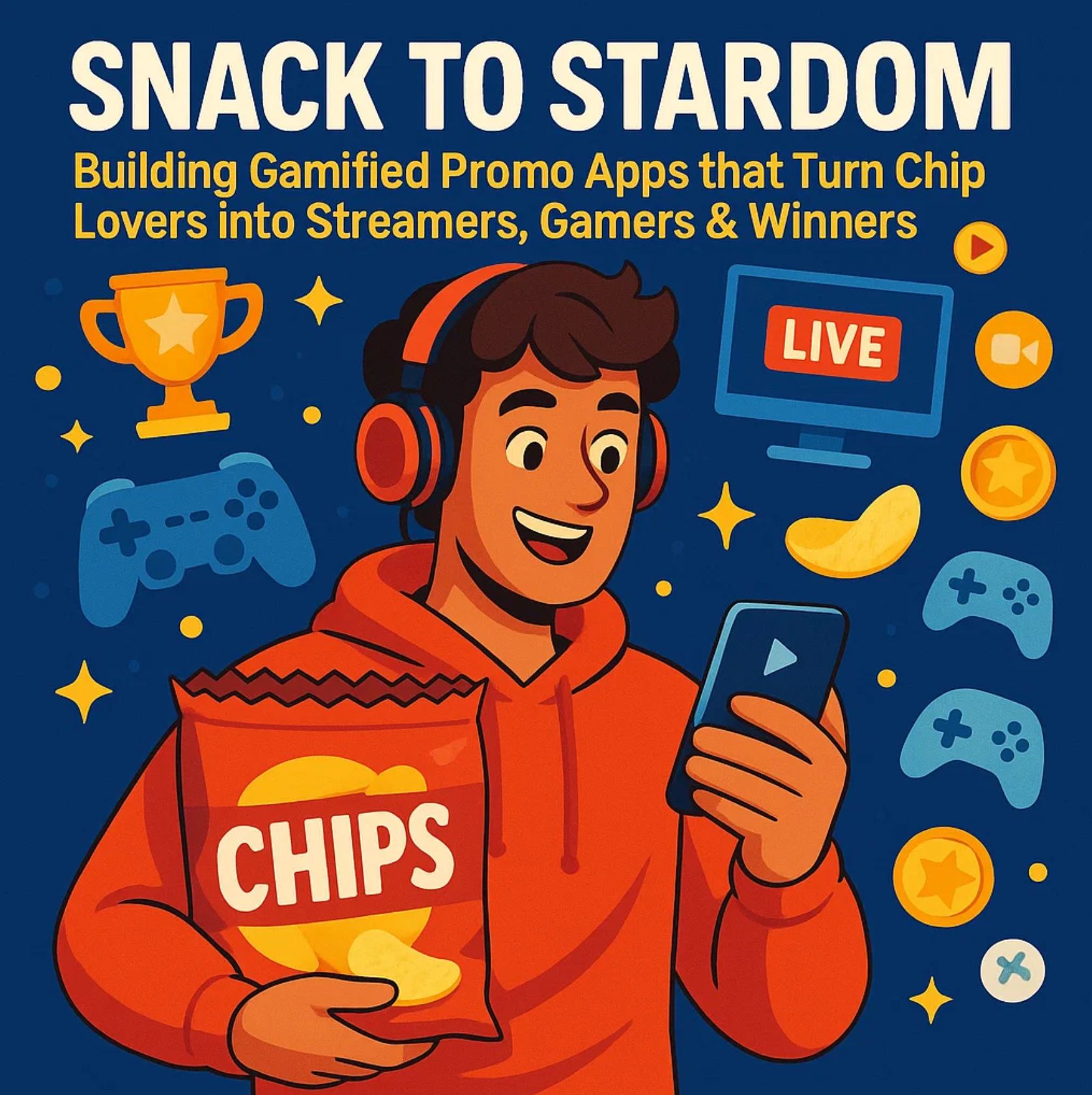
✅ Hashtags
#SnackToStardom
#MobileAppDevelopment
#Gamification
#SnackPromo
#ARMarketing
#LoyaltyApp
#StreamerLife
Other articles
Smart Solar and Battery Storage App Solar panels and batteries are cheaper than ever, but real value emerges only when software choreographs them minute by minute. This in-depth article tracks the cost curves reshaping residential energy, explains the app architecture that forecasts, optimises and secures every dispatch, and unpacks the grid-service markets that now pay households for flexibility. Packed with field data—from NREL bill-savings trials to Tesla’s 100 000-home virtual power plant—it quantifies user ROI across savings, resilience and sustainability. The final section details why A-Bots.com is uniquely positioned to deliver such platforms, fusing AI forecasting, IEC-grade cybersecurity and award-winning UX into a turnkey solution. Whether you build hardware, aggregate DERs or own a solar roof, discover how intelligence—not silicon—unlocks the next decade of energy value.
Custom App Development for Smart Hydroponic Gardens Controlled-environment agriculture is booming, yet success hinges on software that can orchestrate pumps, LEDs, nutrients, and climate in real time. In this in-depth guide A-Bots.com walks you through the full technology stack—hardware, edge intelligence, secure connectivity, cloud analytics, and UX—showing how each layer compounds into measurable savings. You’ll see case data on 90 % water reduction, 20 % yield gains, and pay-back periods as short as 26 months, plus a four-stage methodology that de-risks everything from proof-of-concept to fleet-scale OTA updates. Whether you’re a rooftop startup or an appliance manufacturer, learn how bespoke app development transforms a hydroponic rack into a transparent, investor-ready food engine—and why the next billion city dwellers will eat produce grown by code.
App Development for Elder-Care The world is aging faster than care workforces can grow. This long-read explains why fall-detection wearables, connected pill dispensers, conversational interfaces and social robots are no longer stand-alone gadgets but vital nodes in an integrated elder-safety network. Drawing on market stats, clinical trials and real-world pilots, we show how A-Bots.com stitches these modalities together through a HIPAA-compliant mobile platform that delivers real-time risk scores, family peace of mind and senior-friendly design. Perfect for device makers, healthcare providers and insurers seeking a turnkey path to scalable, human-centric aging-in-place solutions.
Offline AI Agent for Everyone A-Bots.com is about to unplug AI from the cloud. Our upcoming solar-ready mini-computer runs large language and vision models entirely on device, pairs with any phone over Wi-Fi, and survives on a power bank. Pre-orders open soon—edge intelligence has never been this independent.
Custom Drone Software Mastery - ArduPilot and MissionPlanner This long-read unpacks the commercial drone boom, then dives into the technical backbone of ArduPilot and Mission Planner—one open, multi-domain codebase and a ground station that doubles as a full-stack lab. From rapid-prototype firmware to data-driven optimisation retainers, A-Bots.com shows how disciplined codecraft delivers measurable wins: 40 % fewer mission aborts, 70% faster surveys, and faster BVLOS approvals. Finally, the article looks ahead to AI-augmented navigation, Kubernetes-coordinated swarms and satellite-linked control channels, detailing the partnerships and R&D milestones that will shape autonomous, multi-domain operations through 2034. Read on to see why enterprises choose A-Bots.com to turn ambitious flight plans into certified, revenue-earning reality.
Top stories
Copyright © Alpha Systems LTD All rights reserved.
Made with ❤️ by A-BOTS
